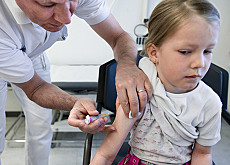National flu campaign gets a boost

The federal health authorities have called for more people to be vaccinated against influenza, which kills an estimated 1,000 people a year in Switzerland.
They say not only those people at particular risk, including the elderly, should be immunised but also those who come into regular contact with them. A national flu vaccination day is being held on Friday.
But there is no reason to panic about a virulent strain of flu coming from Australia, say officials.
The call forms part of a new strategy – the latest step in Switzerland’s anti-flu campaign – the details of which were announced in early October.
Flu, or influenza, is a viral infectious disease of the lungs and upper airways. It normally appears in winter and can have an infection rate of between five and 20 per cent. In schools and old people’s homes, this can rise to around 50 per cent.
In Switzerland 92 per cent of the deaths caused by the disease are among old people.
Flu jabs are currently recommended for those over 65, the chronically ill such as diabetes and asthma sufferers, premature babies from the age of six months and those living in care homes.
Family and friends
Immunisations are also advised for medical workers, but until now not enough attention has been paid to other people who might spread the infectious disease, according to the Federal Health Office.
“All those in close contact with people at risk are also a risk,” spokesman Jean-Louis Zurcher told swissinfo.
Flu spreads through sneezing and coughing as well as from hand contact with an infected person. Family could therefore also be vectors for the disease, as well as visitors and personnel working in care homes.
However, even those not falling into these groups could benefit from immunisation, Zurcher stressed.
At the national immunisation day, organised by health groups and supported by the health office, vaccinations will be administered without appointments. The idea is to target “the healthy” who might not normally think of getting a flu shot.
“It’s a good idea for everyone to get vaccinated because you not only protect yourself, you can also protect other people who are not vaccinated or cannot be vaccinated,” Zurcher explained.
Australian flu
Flu hits countries every year and can rise to epidemic proportions. Media reports have recently warned that a deadlier strain, Brisbane H3N2, from Australia, could reach Europe this year.
It has been reported that this virus affects three times the number of victims hit by other strains, with many deaths resulting from pneumonia.
Between June and July 2007 there were more than 800 flu pneumonia deaths in New South Wales, many of them children.
However, the prognosis for Brisbane H3N2 this year looks good, said Zurcher. “We’re not worried about it because Brisbane is in the vaccine now and the flu season has been quite mild in Australia this year,” he said.
Getting the message
The results of a survey, published on October 6 by the health office, show that Switzerland is slowly getting the message about flu jabs.
The percentage of those immunised among the over 65s has risen from ten per cent to 57 per cent in the period 1999-2007. This vaccination rate tallies with other western countries, Zurcher said.
The French-speaking part of the country has the highest rate with one in six of over 65s having received a flu shot.
In all, up to 300,000 people consult their doctors about influenza in Switzerland each year, according to official figures. Up to 5,000 may end up in hospital.
Direct costs to the health system are estimated at SFr100 million ($87.6 million). If other factors, such as sick leave, are taken into account, this rises to around SFr300 million, according to the health office.
swissinfo, Isobel Leybold-Johnson
The main symptoms of flu are a high temperature and general aches and pains. Loss of appetite and a harsh cough may also appear. The illness may last for up to three weeks.
On average it takes two days to go from being infected to the full symptoms and people normally remain infectious for around five days after the symptoms become apparent. Those in risk groups may remain infectious for longer.
The best time to have a flu shot is mid-October to mid-November before the flu season begins (December-February), according to the Federal Health Office.
The National Strategy for the Promotion of Flu Immunisations 2008-2012, published in the health office’s bulletin on October 6, continues the country’s flu campaign started in 2001.

In compliance with the JTI standards
More: SWI swissinfo.ch certified by the Journalism Trust Initiative











You can find an overview of ongoing debates with our journalists here . Please join us!
If you want to start a conversation about a topic raised in this article or want to report factual errors, email us at english@swissinfo.ch.